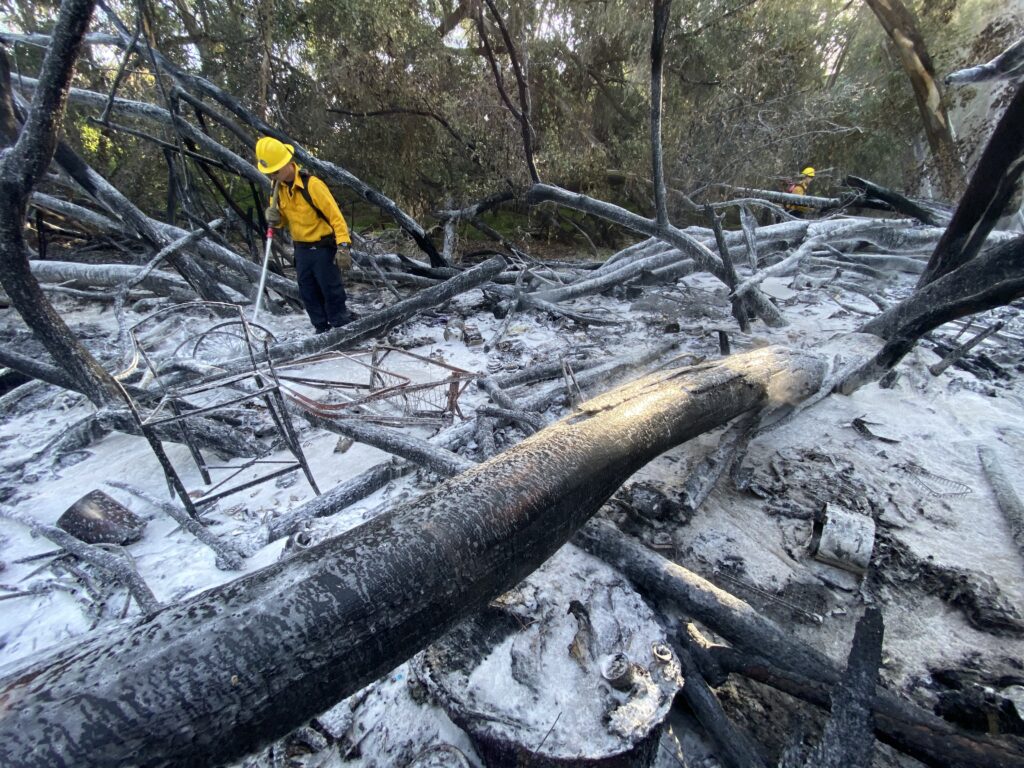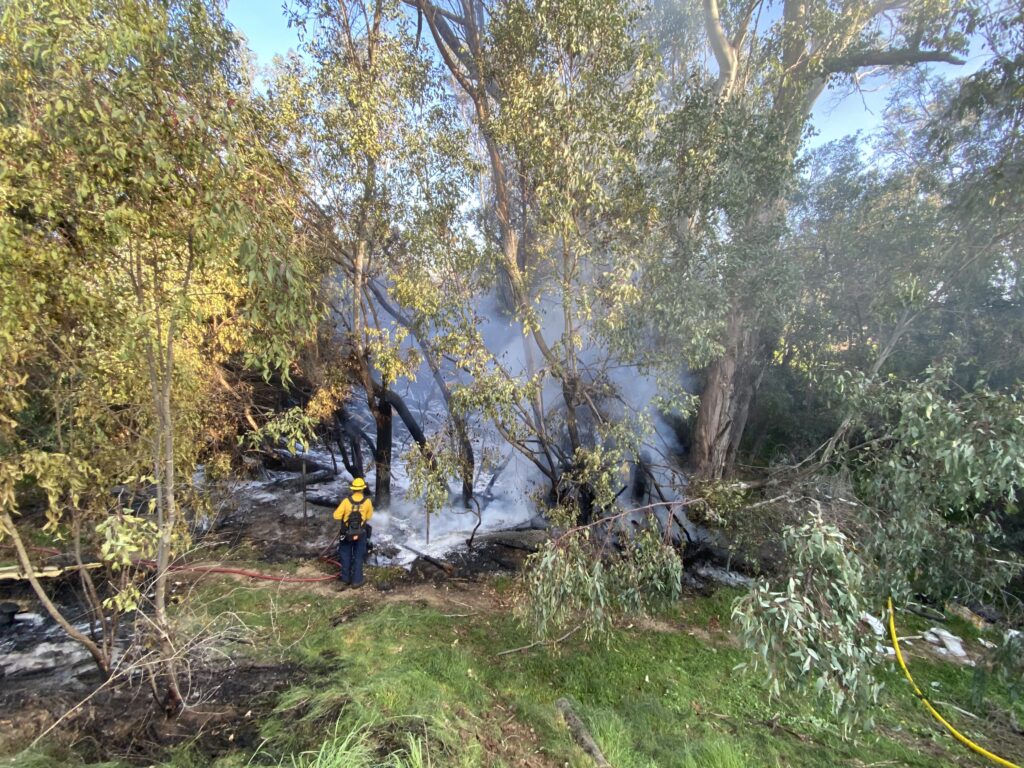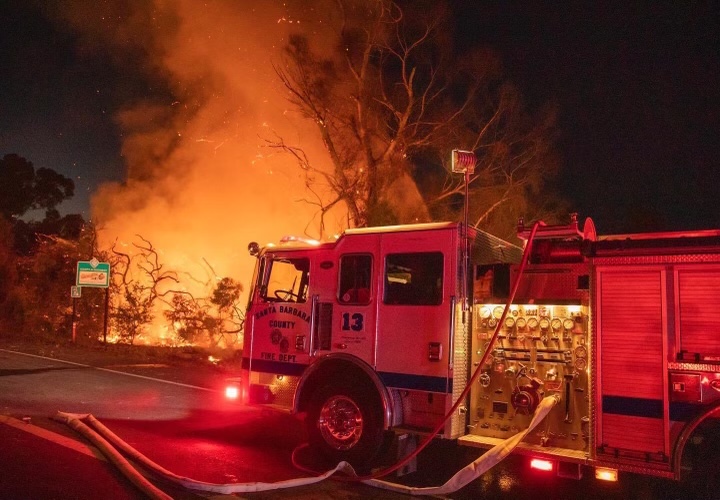With consistent warm weather through most of the year and breathtaking scenery it is very obvious that a city like Santa Barbara attracts many people from all walks of life, especially the homeless. Homelessness is a problem in Santa Barbara that has affected the city for a long period of time. Fires have also plagued the city and effectively the whole county. According to statistics from the Santa Barbara County Fire Department, illegal campfire responses went up ten times in 2020 compared to 2019. These two problems do not mix well and have (for the past 12 months) caused major complications that put many different city departments in a standstill on how to address the problem of homeless encampment fires. Encampment fires have been on the rise in the city of Santa Barbara and in a more grand sense the county as a whole. While the source of these fires are well known not much is being addressed in order to prevent future fires. With different laws, court cases, complex history, and moral dilemmas it is very hard to find an effective strategy that addresses all aspects of homeless encampment fires.
To address the ongoing problem of encampment fires in Santa Barbara one must look at the source of why these encampments were erected in the first place and what is the main cause of these fires. When the fire investigator for Santa Barbara City Fire Department Ryan DiGuilio was questioned on the origins of these encampments he responded with “the economics that have come out of events like the pandemic and how some people have been forced out of their houses or living in their cars, we’ve definitely seen an increase in the transient (homeless) population relative to the past 12 months.” While the homeless population in Santa Barbara was elevated compared to its neighbouring communities, it was nothing in comparison to the rise in homelessness in 2020 due to economic instability that came from the Covid-19 pandemic according to DiGuilio.

Another reason for the existence of these encampments is partially due to their legal right to set up camp on public property because of the Martin v. Boise court case which started in 2009 and was not decided until 2019. Robert Martin was a homeless man living on the streets of Boise, Idaho in 2009. Boise was more hostile towards the homeless in 2009 than it is now, in order to sleep or set up an encampment on the streets one must have a warrant which was virtually never given out. Failure to acquire this warrant allowed you to receive hefty fines. Martin, who had trouble walking, was resting near a shelter and was fined 150 dollars. On October 22nd, 2009 he and nine other individuals sued the city for violating their eighth amendment right of unlawful punishment. The city however still retracted some of its very restrictive rules on the homeless in January of 2010 they didn’t allow law enforcement to take action on the homeless if shelters were full as well as only enforcing previously said Bosie rules during the night time and never during the day. Once the case was ruled in the court of appeals in 2018 and rejected to be heard by the supreme court in 2019, many interpretations were already made about the lawsuit. For example, in Sacramento it is legal to sleep outside the city hall during the nighttime but not during the day. Or in Santa Barbara when DiGuilio was asked about a change in strategy to address encampment fires after the recent Loma Alta fire that ragged on T.V. Hill responded with “The city council decided on how to address the fires specifically along the railroad corridor (where the train tracks come through) which was a really big heavily populated transient area. With collaboration with multiple different departments [Police department, County and City Fire departments] they recognized those areas as ‘high fire hazard areas’ because of the vegetation around the area. They declared an emergency ordinance in which the public were not allowed to camp in these areas.” While public places like these saw a dramatic decrease in encampment fires, one could make the argument that the city purposefully marked highly populated areas in terms of homeless encampments and homeless people in order to remove them out of those public areas and hope they go somewhere else, which is a violation of Martin v. Boise. When DiGuilio was asked if the decision made by the city council was a contradiction to the Bosie court case he responded with “it is; only in the fact that the government or agency would need to have something that superseded the court case. The city deemed those areas to be high fire hazard because of the dead vegetation and the number of fires that happened there which is probably how they dealt with that court case.” He then went on and said that while “the land is used by all either by cal trans or union pacific, however, they are technically privately owned because Union Pacific is a railroad company.” Since the railroad and the area around it is privately owned they technically have the right to kick anyone off their land, but it is kind of odd that DiGuilio said it’s publicly owned land then references railroad companies owning said public land.
When Division Chief and Fire Marshal Rob Hazard was asked on the origins of these encampments, he gave a more different response and states a few reasons, one of them being “Definitely Covid as the CDC (center for disease control) put out guidance (he said “guidance” with great emphasis and made sure that it was not a rule the CDC put out) to federal, sate, and local governments that warned them of interacting with the homeless because they all get packed into different shelters which cause superspreader events.” Another reason he gave was “[the United States’] economy for a long time (Covid did make it worse, but ever since The Great Recession in 2008) has mostly benefited the middle and upper class, while not benefiting those below the poverty line.” It is very obvious to see the fine line between who has the resources to recover from different events like the 2008 recession or the current global pandemic, and who does not (usually those who are homeless and start creating these encampments). The current economic situation for most Americans and more specifically those in Santa Barbara have led to some resorting to a life riddled with extreme poverty and desperation to achieve resources that more fourtinite people can achieve with ease. This desperation of resources can have a great effect that can impact many people. An example of this is the Loma Alta Fire which was caused by a man who was clearly in need of mental help and more likely could not afford said help. Lack of resources for this man (mostly because he could not afford it in the first place, prior to him being eligible for any type of government help) caused multiple houses and a news station to be put at risk of burning down.

When Hazard was asked if he’s ever seen the County Fire department contact law enforcement assist on addressing specific encampments he responded with “there is a very big reluctance [from the police department and sheriffs] to use trespassing laws to get rid of homeless encampments, they prefer for it to be addressed through social services.”Hazard understands why as he saids right after “many people would be opposed to that, and the law enforcement community are somewhat reluctant.” While law enforcement does not take part in removing the homeless, this can have a few positive and negative effects. A positive effect is that they do not violate any humanitarian laws and rights established by multiple local and global organizations. A more negative effect is that the homeless may get the wrong idea and believe they can set up camp wherever and not face any repercussions. The Santa Barbara Police Department gave no response when asked to participate in this feature story.
When Hazard was asked how these fires are started he responded with “however your fire is started you have to look on this pick list, was it a campfire or was it someone that was smoking in their tent. We would have to pick what most fits with the cause of this fire “sometimes it isn’t a campfire, sometimes it might be ribish.” Hazard followed up with “it might not be burning wildlife but just burning trash, in these encampments you tend to see a lot of rubbish.” Those native to Santa Barbara know what Hazard is talking about as major encampment hotpots like many on and off ramps across the 101 have large communities with multiple piles of trash. Hazard warned that “if they are in a back alley or near a building and start a rubbish fire then they could set the whole budding on fire.” He then offered information from the County Fire Department that stated in 2019 in which there were only one to two emergency responses from the county fire department related to illegal campfires. In 2020, that number was 20, a ten times increase within the span of a year. When arson investigator Jay Snodgrass was questioned on the origins of these encampment fires he said “it could be a makeshift tent with a fire inside…If they fall asleep while they have the fire going, an ember could fall into the improvised carpeting and start a fire.” He continued about another potential cause and claimed “[the homeless] could have heaters in there” Snodgrass then makes a theory that the homeless are afraid that the public would call authorities on their cooking fires which are burning on the outside and say they are starting a fire. Snodgrass then said “They are trying to hide them, to make them not as obvious so the fire department and the police department do not show up.” Another cause that Hazard, Snodgrass, and DiGuilio all responded with was “generators.” Generators getting into the homeless possession is another story in itself, but most are acquired through waste or steeling.

When it comes to assessing the city and fire departments strategy and actions to addressing homeless encampment fires, it is very much up to the individual’s interpretation of what is a “good” or “bad” strategy. The city has taken more enforcement as they passed the emergency ordinance in the aftermath of the Loma Alta fire and kicked the homeless out of specific hotspots along the railroad which contain high vegetation and are susceptible to fires. This has led to them moving over to neighbouring communities like Goleta and along their part of the 101 freeway. Hazard claimed to have seen new encampments pop across goleta and especially the freeway that he has never seen before. While the city may see a decrease in vegetation fires and illegal campfires in these high risk areas in the Santa Barbara city limits, folks like Hazard and other residents of neighboring communities in the county may have to deal with the effects of the ordinance as they see increases in their homeless population and more significantly, encampment fires. Elizabeth Stotts and Rene Eyerly, two staff members who are addressing homeless encampment fires in the city of Santa Barbara gave no response when asked to participate in this feature story.
When DiGuilio was asked how the city fire department is addressing the encampment fires and preventing future fires that are a product of the rise of homlessness and encampments he said “were just in that collaborative effort with teams of people that are trying to get these people housed and get them off the streets so they can be warm for the night and not cook in any unapproved containers that can start fires and try our best to prevent another Loma Alta fire.” When asked where the department has found most success, DiGuilio’s response was “trying to get these folks to take advantage of the services that are being provided for them, and trying to get them out of the high fire zones.” Hazard’s response to the same question but in context on the county fire department was “ our role is to evaluate if a section of an area is a life safety or fire hazard, just like how we evaluate a business we send our inspectors to inspect on different encampments to see if they have campfires, barbeques, car batteries used to charge phones, generators that were buried in the ground so they became sound proof which gave them electricity to watch T.V.” He then went on and said that “we have seen encampments that have built makeshift houses from scrap wood and tarps that look like a minisheed.” Hazard then described what they do with this information: “we map it out on our I pads through a specific app, this information is for the public to see through reports. We then get to determine if a specific spot is a low or high fire hazard zone. The final thing we do is if the occupants are there we tell them what they are doing that is causing it to have risk.” Hazard explained that they knew they were going to start a fire so they tried their best to educate these people. Hazard was not too confident about the education being very effective but claimed to be duty bound so they have an obligation as a department to educate the people. When DiGuilio was informed about Hazards remarks towards education of how to prevent these fires, he tended to agree.
Hazard claimed that the issue of encampment fires is a “myriad of problems that make it worse and worse.” Various socioeconomic factors that span for decades play a role in the origins of these homeless encampments, as well as lack of knowledge and desperation of resources can be attributed to the rise of encampment fires. While both the county and city fire departments have desperately tried to educate those most commonly found in these encampments, this strategy seems to barely affect the situation in a positive way. When asked about how he would address the situation, Hazard responded with a temporary transitional center that acted as a campsite so the homeless could bring their belongings to these places while being evaluated and rehabilitated. But what are the chances that the city or taxpayers are going to get behind an inherently expensive project like the one Hazard proposed? DiGuilio (who was asked the same question) gave a more simple response and claimed that he would take a similar strategy the city is taking. How would neighboring communities like Goleta or Montecito react to the city using the current strategy of removing homeless in specific hotspots, just for them to go to their communities. “The only way governments can respond to encampments initially, generally, is through law enforcement” Hazard claims, but how can one use enforcement when sheriffs and police departments are extremely hesitant about using trespassing laws? While many solutions have been offered from multiple different viewpoints, none have addressed the problem of homelessness and homeless encampment fires as a whole. It is then effectively up to the individual person to decide which is the best strategy to adress this very complex and nuanced problem.
[Image Credits: SB County Fire Department]






Be First to Comment